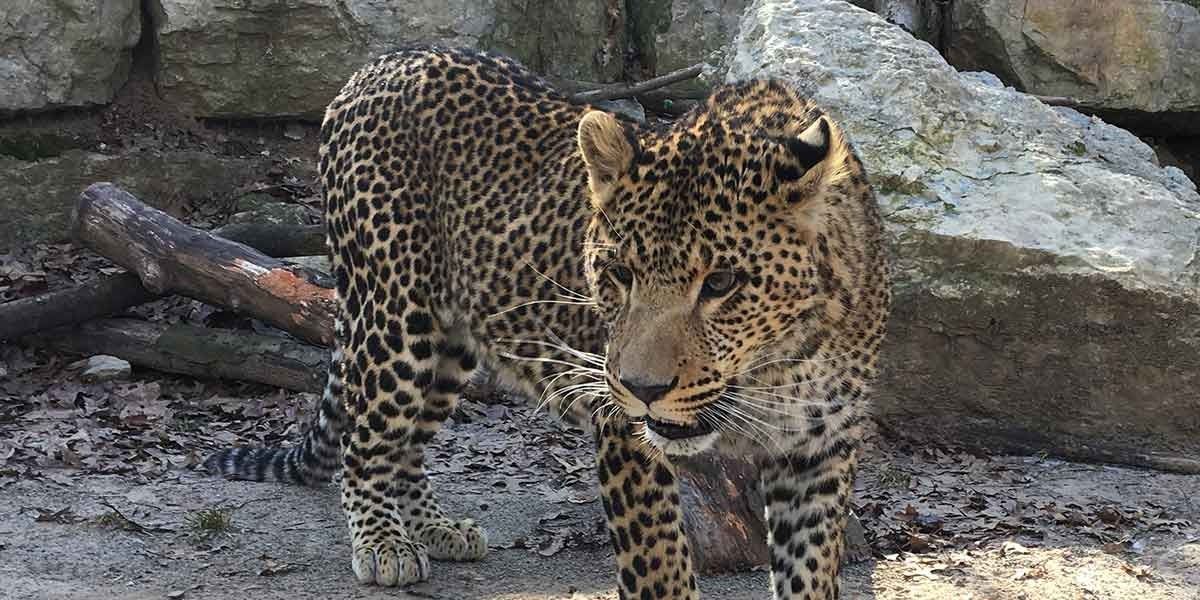African Leopard
The leopard is distinguished by its well-camouflaged fur, opportunistic hunting behaviour, broad diet, and strength (which it uses to move heavy carcasses into trees), as well as its ability to adapt to various habitats ranging from rainforest to flat un-forested grasslands, and arid, mountainous country areas, in addition to its ability to run at speeds of up to 58 kilometres per hour (36 mph).
Throughout their natural range, Leopards have no distinctive breeding season with females instead being able to reproduce every couple of months. After a gestation period that lasts for around three months, the female Leopard gives birth to between 2 and 6 cubs that are born blind and weigh just half a kilogram. Leopard cubs are incredibly vulnerable in the wild and so remain hidden in dense vegetation until they are able to follow their mother around at between 6 and 8 weeks of age, camouflaged by their dark, woolly fur and blurry spots. Weaned at around three months old, Leopard cubs will remain with their mother for another 18 months until she is ready to mate again and encourages her young to independently establish their own territories.
Leopards are commonly found throughout sub-Saharan Africa and southern Asia.
The Leopard is a solitary and nocturnal hunter that hunts both on the ground and in the trees. They are excellent climbers and spend the vast majority of the daytime hours resting in the shade of the branches in the trees or under a sheltered rock. Leopards rely heavily on being able to get close enough to their prey before ambushing it, rather than expelling vast amounts of energy in a high-speed chase.
Throughout their natural range, Leopards have no distinctive breeding season with females instead being able to reproduce every couple of months. After a gestation period that lasts for around three months, the female Leopard gives birth to between 2 and 6 cubs that are born blind and weigh just half a kilogram. Leopard cubs are incredibly vulnerable in the wild and so remain hidden in dense vegetation until they are able to follow their mother around at between 6 and 8 weeks of age, camouflaged by their dark, woolly fur and blurry spots. Weaned at around three months old, Leopard cubs will remain with their mother for another 18 months until she is ready to mate again and encourages her young to independently establish their own territories.
Leopards are commonly found throughout sub-Saharan Africa and southern Asia.
The Leopard is a solitary and nocturnal hunter that hunts both on the ground and in the trees. They are excellent climbers and spend the vast majority of the daytime hours resting in the shade of the branches in the trees or under a sheltered rock. Leopards rely heavily on being able to get close enough to their prey before ambushing it, rather than expelling vast amounts of energy in a high-speed chase.
Fun Facts
• Leopards can see in the dark making it easy for them to catch their prey at night
• The leopard is nocturnal
•They are excellent climbers
• The leopard is nocturnal
•They are excellent climbers

scientific classification
Kingdom
Animalia
Phylum
Chordata
Class
Mammalia
Order
Carnivora
Family
Felidae
Genus
Panthera
Species
P. pardus
did you know?
The Leopard can run at speeds up to 58 km/h
Leopards have no distinctive breeding season
The gestation period of a Leopard is around three months
Where to find us
The African Leopard can be found in the Silent Forest
Safari Niagara is home to two African Leopards, Adele and Apollo.
Safari Niagara is home to two African Leopards, Adele and Apollo.



